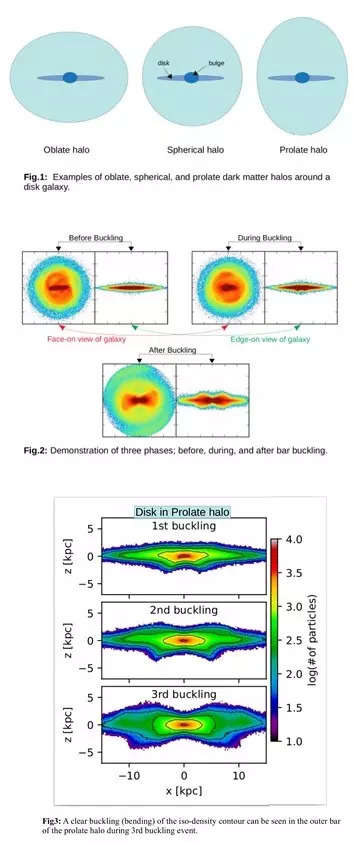By pointing out that the bar’s plane bending in barred galaxies (a central bar-shaped structure made of stars) is a rare violent bar thickening mechanism known as buckling, scientists say there are trillions of stars in our universe. Galaxies have different sizes and shapes, which are determined by the motion of their stars.

“Our own galaxy – Galaxy — A disk galaxy composed of stars moving in circular orbits around the center in a flattened disk, with a dense collection of stars at the center called a bulge. These bulges can range in size from roughly spherical to as flat as a galaxy disk. At the center of the galaxy is a flat boxy or peanut-shaped bulge. Such bulges are formed due to the thickening of stellar bars in galaxies. One of the interesting and violent thickening mechanisms is where the bar bends out of the plane of the galaxy disk,” the scientists have said.
Pointing out that many recent numerical and observational studies suggest that dark matter halos are spherical, prolate (a sphere crushed by the arms), or oblong in shape (a sphere from above and below), he said that although , its effect on stellar bulges and kinematics in bars is not well understood.
in his current work under the leadership of Ankit KumarPhD student at Indian Institute of Astrophysics (IIA) and co-author Pro Moushumi Daso Of ia and Sandeep Kumar Kataria Shanghai Jiao Tong UniversityIn this study, the team investigated the dynamic evolution of galaxies using state-of-the-art numerical simulations at IIA.
IIA is an autonomous institute of the Department of Science and Technology (DST). DST said the team’s simulations show that over eight billion years the bars in the prolate dark matter halo undergo three major bar buckling (out of plane bending) events that make them detectable over long periods of time.
“…This is the first time that three-bar buckling events have been reported in any study. Boxy/peanut-shaped bulges that form as a result of bar buckling are strong in prolate dark matter halos, and Bar Buckling’s signature is the most durable of them all. The work is published in the peer-reviewed journal Monthly Notices of the Royal Astronomical Society.”
The researchers concluded that the rarity of the buckling events observed along with the many buckling events in the prolate halo simulations indicate that the shapes of dark matter halos in most barred galaxies may be oblique (a region from above and below) or spherical. .
“We have studied the effect of non-spherical dark matter halos on the shape of disk galaxies, by generating realistic simulated galaxies and developing them over time using the supercomputing facility available at IIA, Bengaluru,” said Ankit Kumar. paper.
“In our universe, it is very rare to detect ongoing buckling events. To our knowledge, there are only eight galaxies in the observations that are currently undergoing buckling. Our study shows that most of the barred galaxies have prolates.” The halos may be more flattened or rounded instead,” the authors said.
He explained that each occurrence of buckling makes the bar thicker. During the first buckling, the innermost region of the bar becomes thicker, while in subsequent buckling events the outer region of the bar becomes thicker.
,